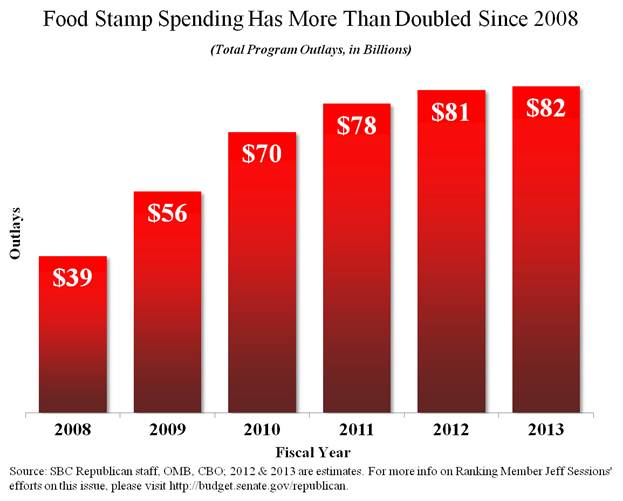The number of Americans on food stamps (or, as it is now called, the Supplemental Nutrition Assistance Program, or SNAP) is higher than ever before, according to a new Congressional Budget Office report. Since 2007, rolls have grown by 70 percent. And participation rates are expected to increase over the next two years.
While some of the growth can be attributed to the recession, participation rates were steadily climbing prior to the recession. Since 2000, the number of Americans on food stamps has jumped by roughly 260 percent, from 17.2 million to 44.7 million in 2011.
Naturally, government spending on food stamps has also jumped, from approximately $20 billion in 2000 to a whopping $78 billion last year, a nearly 400 percent increase.
The growth in participation rates seems to be part of the federal government’s goal, as a report from the U.S. Department of Agriculture released just this month explains.
The food stamps program is just one part of an ever-expanding government welfare system that includes not only 12 food assistance welfare programs but a total of 79 federal welfare programs. These programs provide not only food assistance but cash, housing, energy and utility assistance, education services, child care, medical care, and so forth.
The total cost of these programs reached $927 billion last year. Welfare is now the fastest growing part of government spending, and despite welfare costs increasing 16-fold since the War on Poverty began in the 1960s—and total spending on cash, food, and housing assistance now twice the amount necessary to pull all Americans out of poverty—President Obama wants to spend more. Aggregate welfare costs are projected to reach over $1.5 trillion in 2022.
As Heritage senior fellow Robert Rector said last week at a House Budget Committee hearing, out of control welfare costs are contributing to “ruinous and unsustainable future budget deficits.”
To get spending under control, Congress can roll back current welfare spending to pre-recession levels (adjusted for inflation) once the current recession ends and then capping aggregate welfare spending at the rate of inflation going forward. Doing so would save American taxpayers more than $2.7 trillion during the first decade.
America’s growing welfare state is creating a system of increased dependence and contributing to a growing federal debt. Helping the poor should mean promoting individual freedom through self-reliance rather than creating dependence through an unsustainable government dole.



























